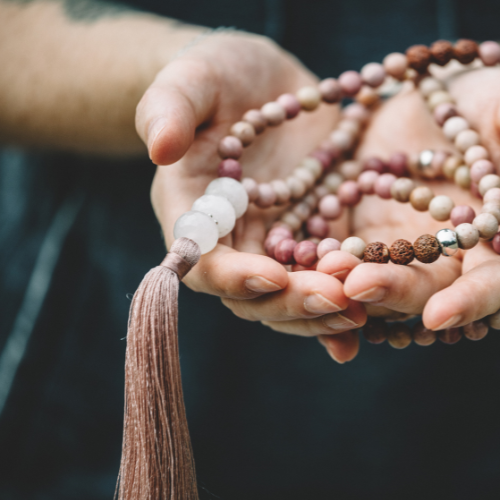Summer can often feel like a time when everything is full on!
We feel obliged to make the most of the lighter and longer days, our social calendars can fill up, we might be juggling kids on school holidays.
It might be a time when we feel rest falls to the wayside, and we could end up to feeling overwhelmed or tired, wired and uninspired!
Rest is essential for maintaining a healthy and balanced life, yet it’s often overlooked in today’s fast-paced world.
Want to know more about rest, and how we can help you to stay cool, calm and connected - keep reading!
Why Is Rest So Important?
Rest is crucial for physical, emotional, and mental recovery.
It helps the body heal, restores energy, sharpens focus, and supports overall well-being.
Rest isn’t just about sleep—it includes downtime, relaxation, and intentional mental breaks.
Types of Rest
Rest is so much more than going to sleep at night (though this is part of it).
We have previously offered a 7 types of rest workshop. Watch this space for more workshops around rest coming soon!
There are actually 7 types of rest. As detailed below.
1. Physical Rest
Passive (e.g., sleep, napping) and active (e.g., stretching, yoga).
2. Mental Rest
Taking breaks from cognitive work; quieting a racing mind.
3. Sensory Rest
Reducing screen time, noise, and bright lights.
4. Emotional Rest
Feeling free to express feelings and avoid people-pleasing.
5. Social Rest
Spending time with positive people or being alone if needed.
6. Creative Rest
Reconnecting with nature, art, or beauty to inspire the mind.
7. Spiritual Rest
Feeling connected to something bigger, such as faith or purpose.
Benefits of Rest
Improved memory and concentration.
Boosted immune system.
Reduced stress and anxiety.
Better decision-making.
Enhanced creativity.
Improved mood,
Faster physical recovery.
Hormone balance.
Increased productivity.
Reduces cortisol (stress hormone).
Improves sleep quality.
Enhances parasympathetic nervous system activity (rest-and-digest state).
Implications of Not Getting Enough Rest
Chronic fatigue.
Weakened immunity.
Mood disorders (e.g., anxiety, depression).
Weight gain or metabolic issues.
Increased risk of heart disease and diabetes.
Burnout and reduced work performance.
Impaired judgment and accidents.
Rest for Men & Women
Men may under-report fatigue or push through exhaustion due to cultural expectations around toughness or productivity.
Women often juggle multiple roles (career, caregiving) and experience higher rates of chronic stress, which can affect sleep and emotional rest. Statistics have shown that women need more sleep than men.
Hormonal fluctuations (e.g., menstrual cycle, pregnancy, menopause) can also impact the quality and type of rest women need.
UK Statistics About Resting
Recent UK studies found:
1 in 3 Brits don’t get enough sleep.
74% of adults have felt so stressed in the past year they were overwhelmed or unable to cope (Mental Health Foundation).
80% say they don’t take enough breaks during work.
Average UK adult sleeps just under 6.5 hours per night, below the NHS-recommended 7–9 hours.
Hints & Tips
Wellbeing practices can sometimes feel like something else to add to the never ending list of things to do. Here at Yoga Borne, we want to offer you wellbeing support and guidance in a holistic and simple way.
Below are some practical tips for bringing more rest into your daily life.
1. Prioritize Sleep
Set a consistent bedtime and wake-up time (even on weekends).
Limit screen time 1 hour before bed.
Create a calming bedtime routine (e.g., warm shower, herbal tea, reading).
2. Take Mini Breaks During the Day
Try the Pomodoro technique: 25 minutes of work, 5-minute break.
Stand up, stretch, or walk away from your desk for a few minutes.
Practice some seated Yoga at your desk.
3. Reduce Screen & Sensory Overload
Mute unnecessary notifications.
Take 10 minutes a day to sit in silence or dim lighting.
Spend some time outdoors—no phone, just nature.
4. Give Your Mind a Rest
Try journaling to unload racing thoughts.
Practice deep breathing or short mindfulness meditations.
5. Be Emotionally Honest
Talk openly with someone you trust.
Let go of people-pleasing and perfectionism.
Allow yourself to feel what you feel—without judgment.
6. Schedule Rest Like a Meeting
Block out time for nothing—even just 15 minutes.
Protect this time as seriously as you would an appointment.
7. Do Something That Recharges You
Listen to music, draw, garden, walk your dog—anything non-stimulating and enjoyable.
Don’t confuse distraction (like endless scrolling) with real rest!
8. Try Restorative, Yin Yoga or Yoga Nidra
Even just 10–20 minutes can deeply calm the body and mind.
We have over 300 FREE practices available on Yoga Borne YouTube.
Practice whenever, wherever here.
9. Cut Caffeine Late in the Day
Switch to herbal teas in the afternoon/evening.
Try calming herbs like chamomile, lavender, or lemon balm.
10. Build in Weekly Downtime
Keep at least one day/night each week unscheduled.
Treat rest as essential—not earned.
Schedule your Yoga classes!
Yoga for Resting
Yoga can be an excellent tool for rest.
Restorative Yoga – Uses props to support the body in passive poses for deep relaxation.
Yin Yoga – Targets deep connective tissues with slow, long-held stretches.
Yoga Nidra (Yogic Sleep) – A guided meditation technique that brings deep mental and physical rest, often equated with hours of sleep.
Our Friday evening 6:15PM STRETCH & REST class is the perfect combination of the above!
And our Wednesday evening 7:45PM STRETCH class is also great for relaxation.
Check out the class descriptions here.
Book your practice here.
Keep a look out for our rest workshops coming soon!





























































